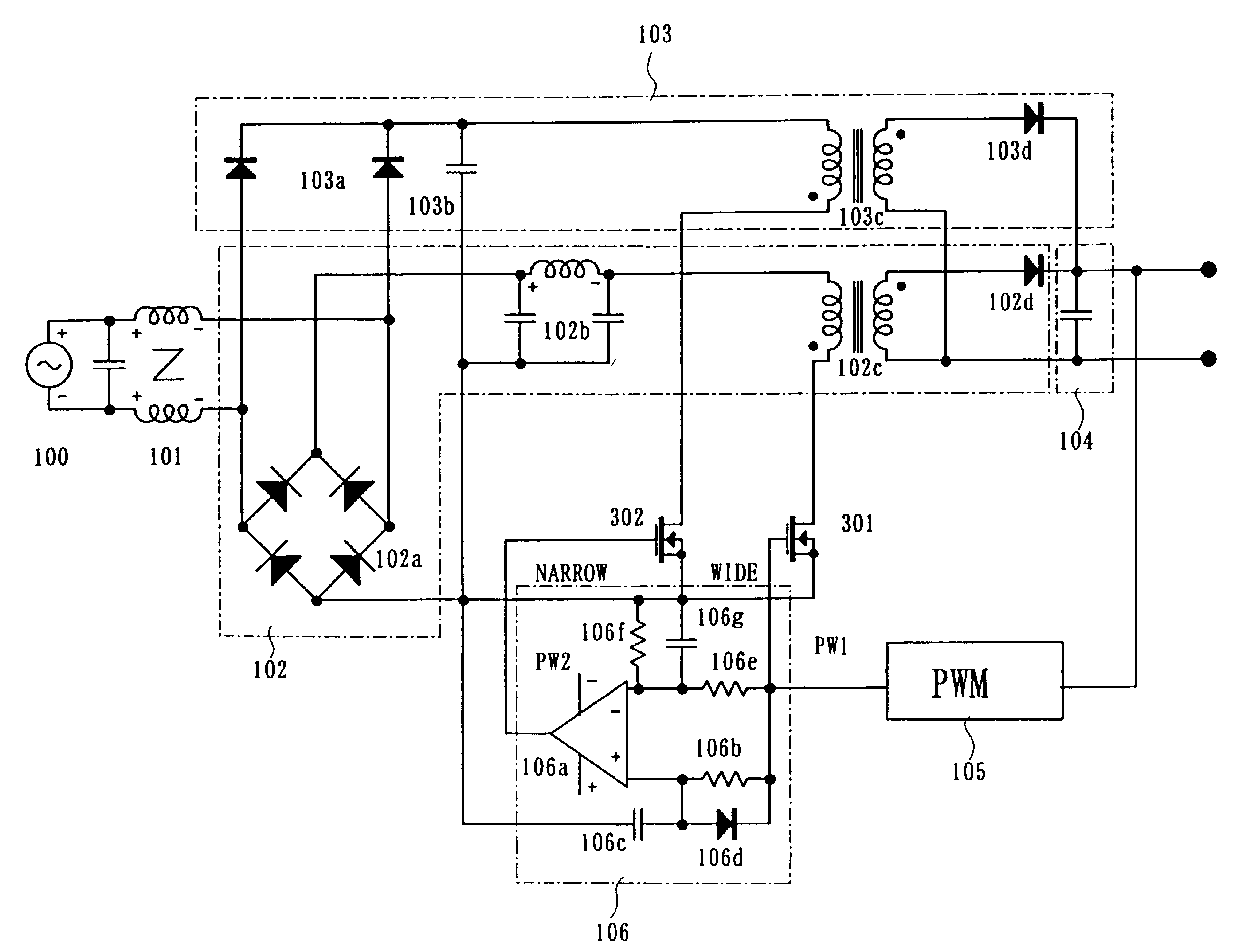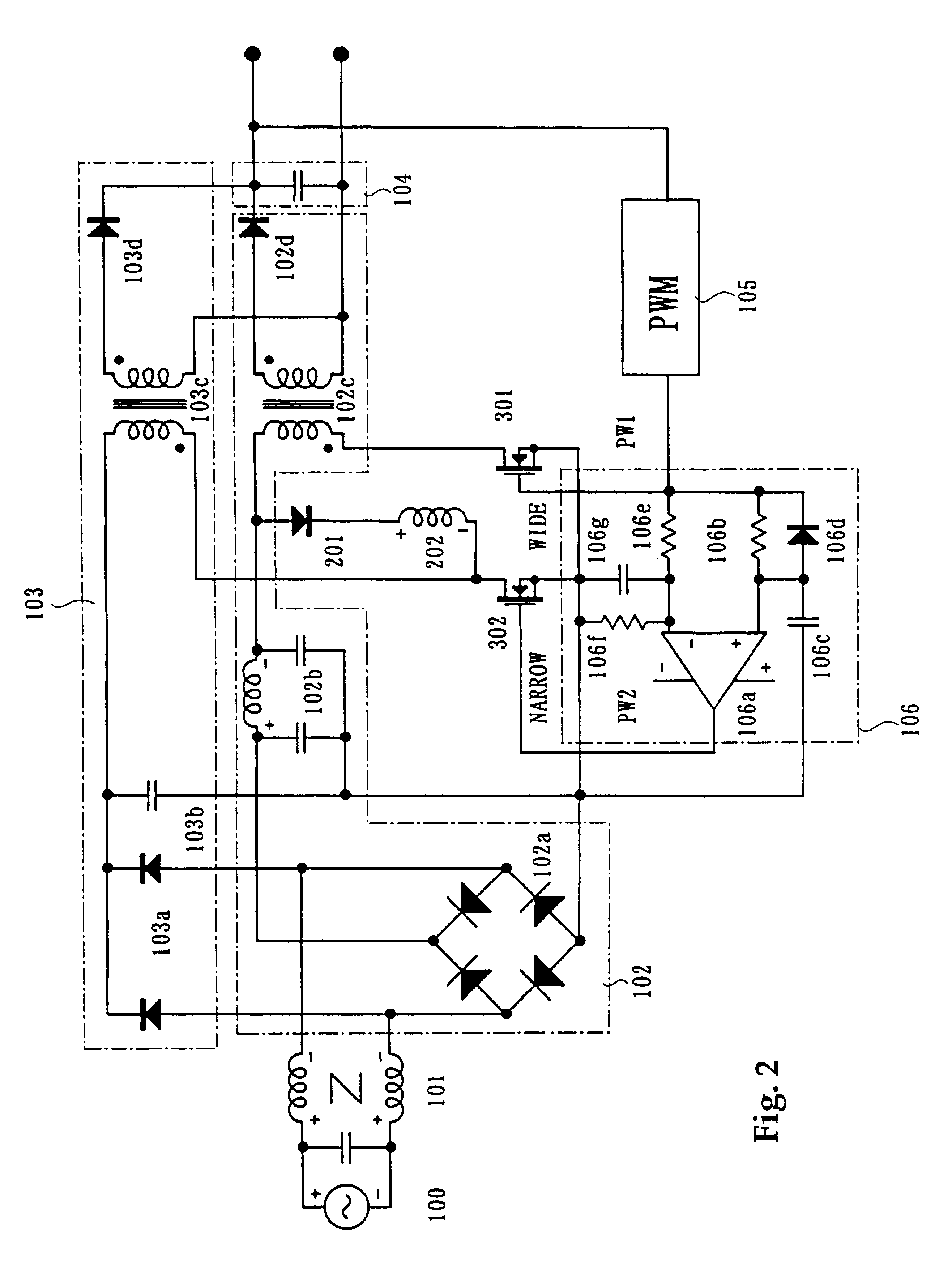Single phase AC-DC converter having a power factor control function
a single-phase ac-dc converter and power factor technology, applied in the direction of electric variable regulation, process and machine control, instruments, etc., can solve the problems of poor efficiency, difficult to meet the harmonics standard in class d, and inability to improve efficiency as expected
- Summary
- Abstract
- Description
- Claims
- Application Information
AI Technical Summary
Benefits of technology
Problems solved by technology
Method used
Image
Examples
first embodiment
The AC-DC converter of the first embodiment has an AC power supply 100, an LC noise filter 101, a PFC power supply section 102, a DC-DC power supply section 103, an output adding and smoothing section 104 for adding outputs of the PFC power supply section and the DC-DC power supply section, a PWM control circuit 105, an ON time delay circuit 106, a first switching element 301 for switching the PFC power supply section and a second switching element 302 for switching the DC-DC power supply section.
The PFC power supply section 102 comprises a bridge diode 102a, a .pi. shaped noise filter 102b, a first transformer 102c, a rectifying diode 102d for rectifying the secondary output of the first transformer 102c. One end of the primary coil of the first transformer 102c is connected to the bridge diode 102a via the .pi. shaped filter 102b and the other end of the primary coil is connected to the first switching element 301.
While, the DC-DC power supply section 103 has a rectifying diodes 1...
second embodiment
FIG. 3 is a circuit diagram showing a modification of the AC-DC converter mentioned in the In this modification, diodes 203 and 204 and an inductor 202 are inserted between the AC inputs and the second switching element 302 in a series manner. According to the construction, when a high input voltage of 200V or more, for instance, is applied, harmonics can be reduced more effectively. It should be noted that both in the converters shown in FIGS. 2 and 3, if a necessary amount of electric current is supplied from the inductor 202 to the smoothing capacitor 103b, the rectifying circuit 103a of the DC-DC power supply section may be omitted.
FIG. 4 is a circuit diagram showing a construction of the AC-DC converter according to the third embodiment of the present invention. In the third embodiment, a tertiary coil 401 is provided in the first transformer 102c (or the second transformer 103c) in addition to the basic construction mentioned in FIG. 1; one of the ends of the tertiary coil 40...
third embodiment
In the third embodiment shown in FIG. 4, an inductor 403 is inserted between the tertiary coil 401 and the smoothing capacitor 103b of the DC-DC power supply section 103. However, an external inductor can be also used, a leakage inductor from the tertiary coil 401 can also be used therefor.
In the third embodiment, if a necessary current is supplied to the smoothing capacitor 103b of the DC-DC power supply section 103 from the tertiary coil 401 and / or the inductor 403, the rectifying diodes 103a of the DC-DC power supply section 103 can be omitted.
Furthermore, the diode 201 and the inductor 202 shown in FIG. 2 and / or the diodes 203, 204 and the inductor 202 shown in FIG. 3 may be added to the third embodiment. In this case, the diode 201 and the diode 403 can be used commonly. In addition, the inductor 202 can be omitted so that only the diode is connected there.
It should be noted that in the AC-DC converters according to the second and third embodiments, even if the pulse widths of ...
PUM
 Login to View More
Login to View More Abstract
Description
Claims
Application Information
 Login to View More
Login to View More - R&D
- Intellectual Property
- Life Sciences
- Materials
- Tech Scout
- Unparalleled Data Quality
- Higher Quality Content
- 60% Fewer Hallucinations
Browse by: Latest US Patents, China's latest patents, Technical Efficacy Thesaurus, Application Domain, Technology Topic, Popular Technical Reports.
© 2025 PatSnap. All rights reserved.Legal|Privacy policy|Modern Slavery Act Transparency Statement|Sitemap|About US| Contact US: help@patsnap.com



